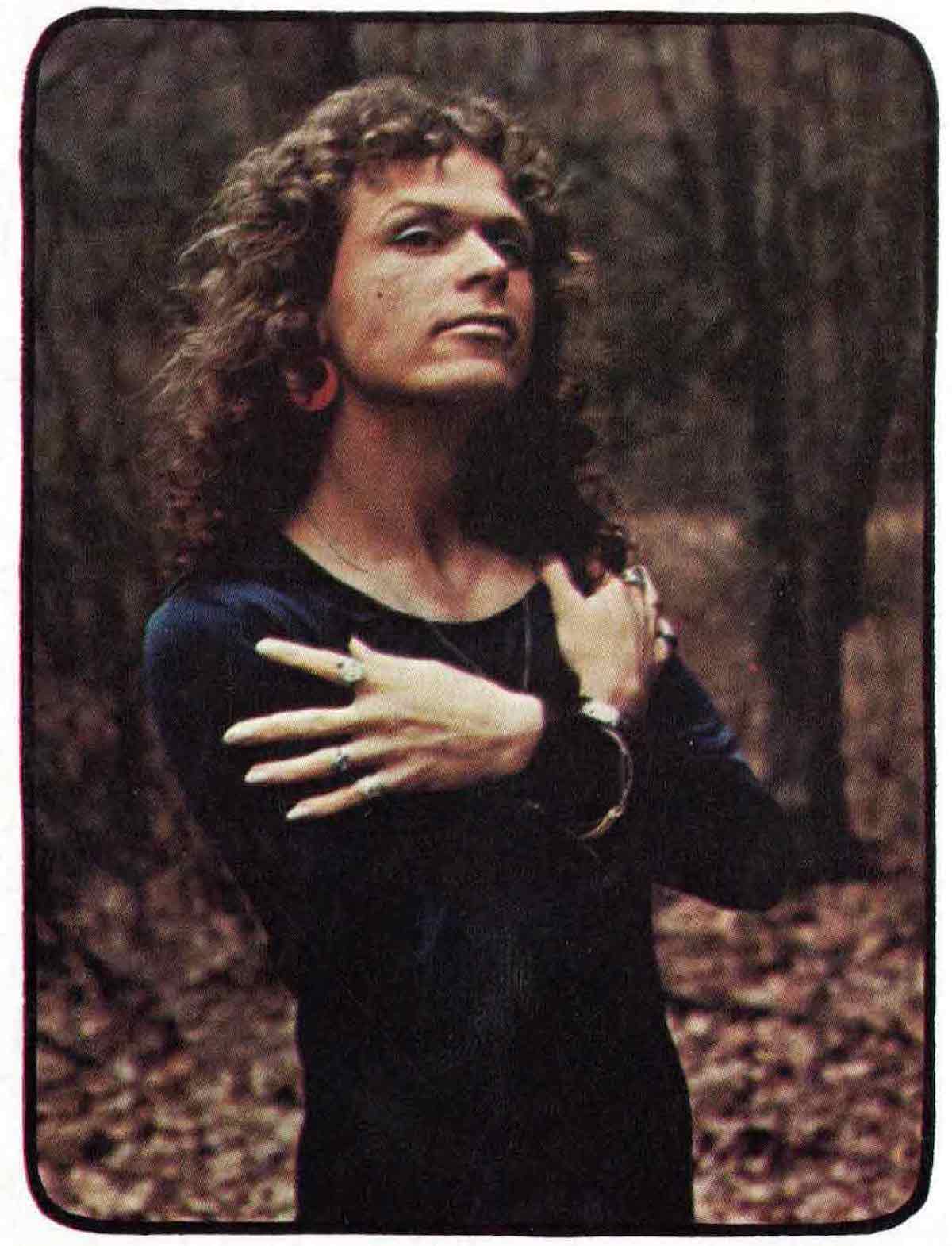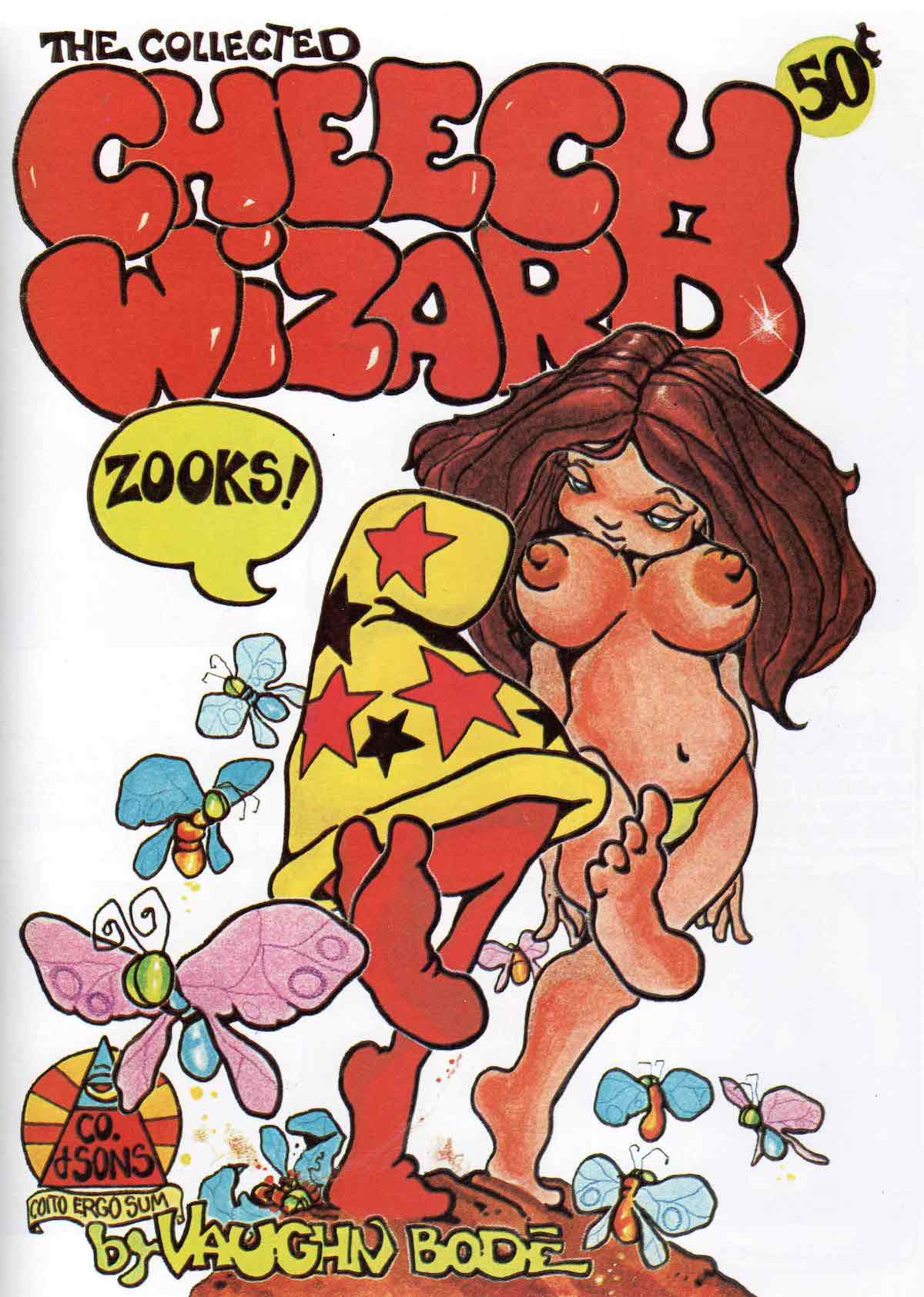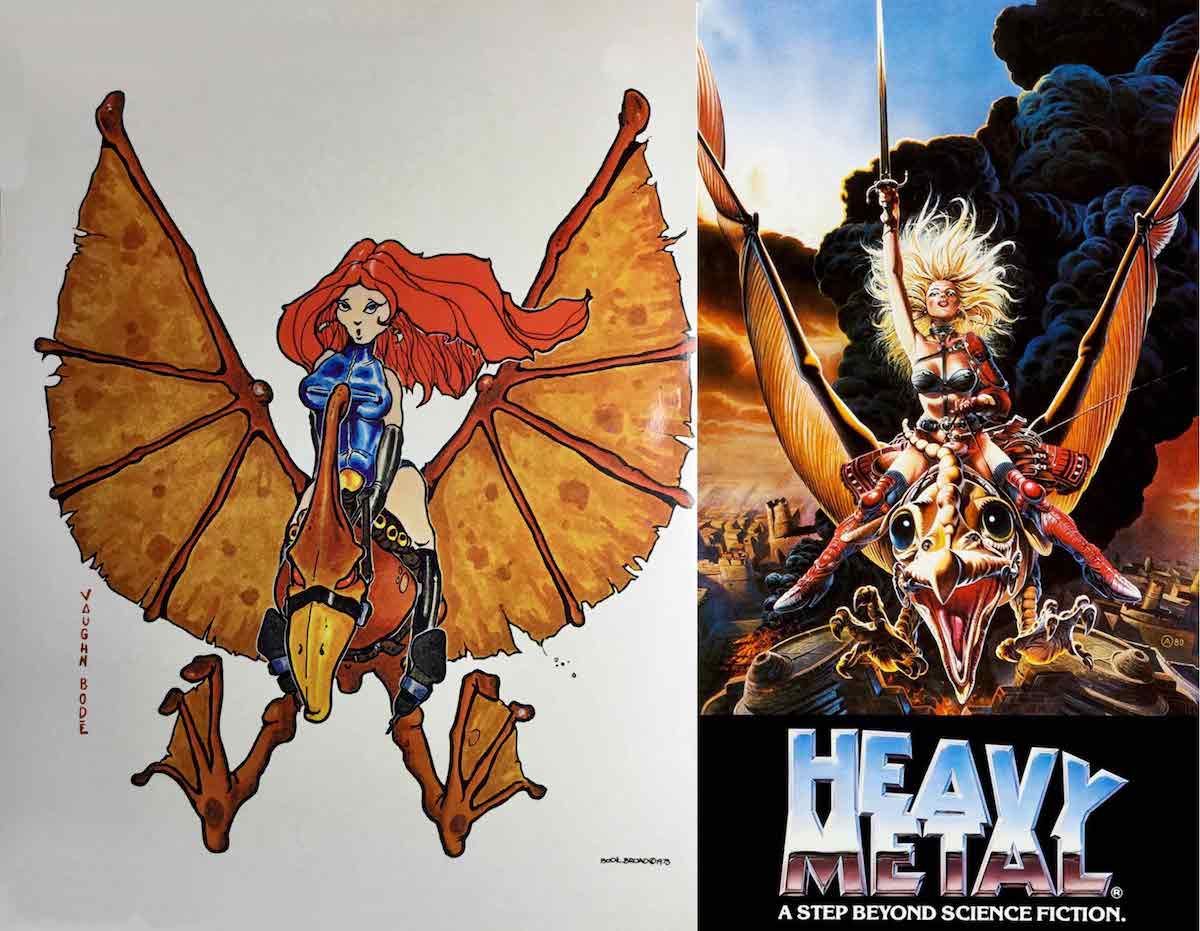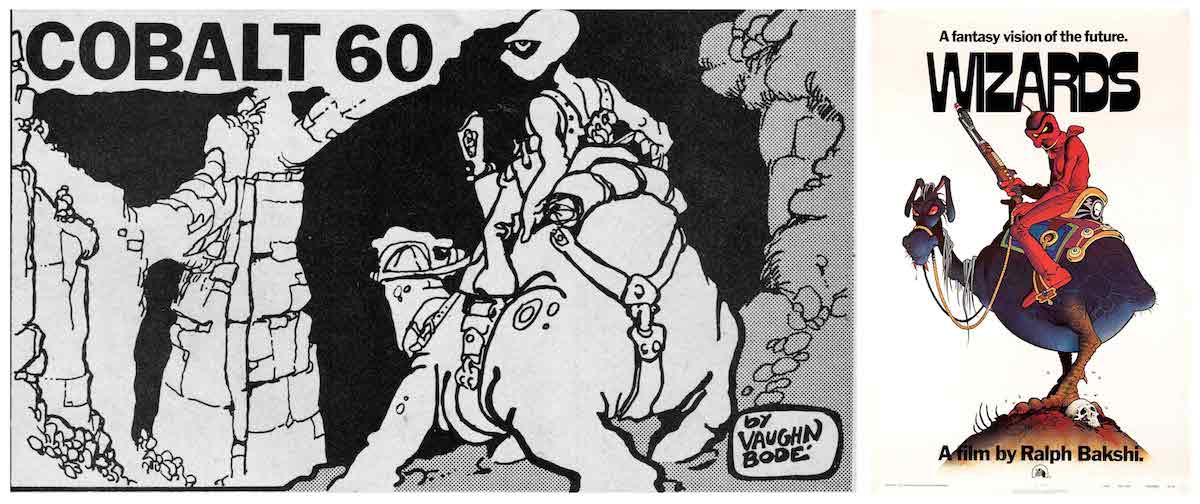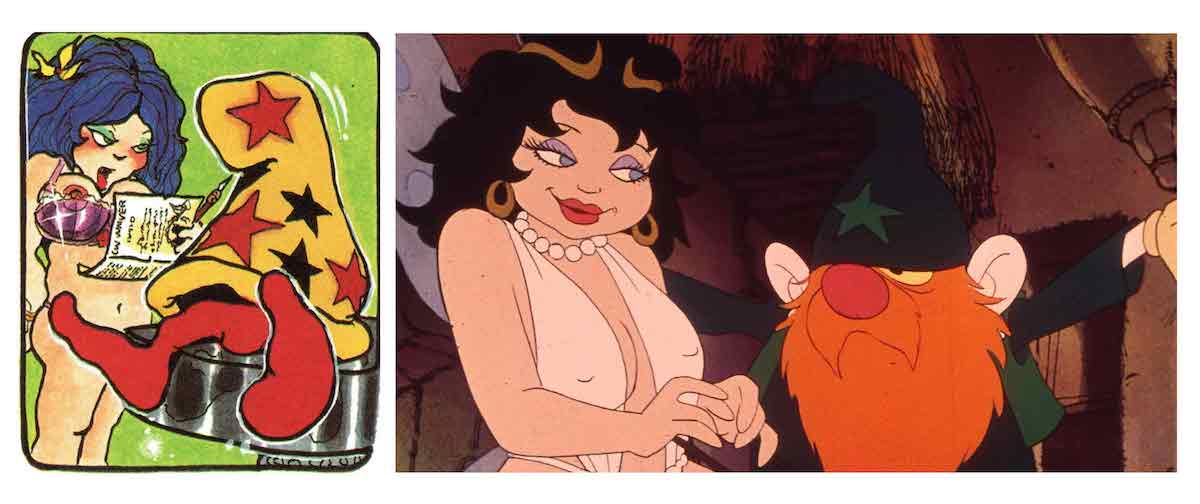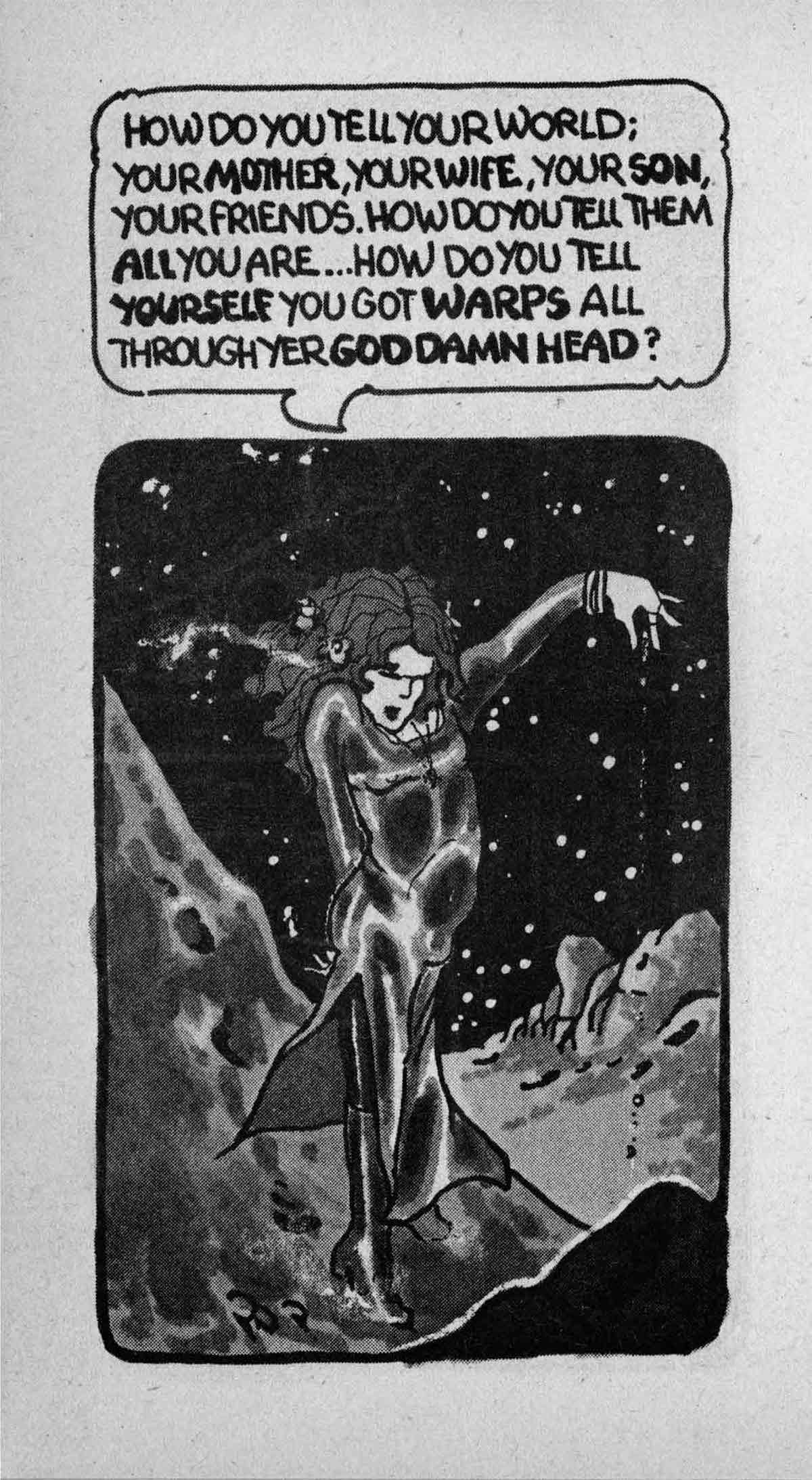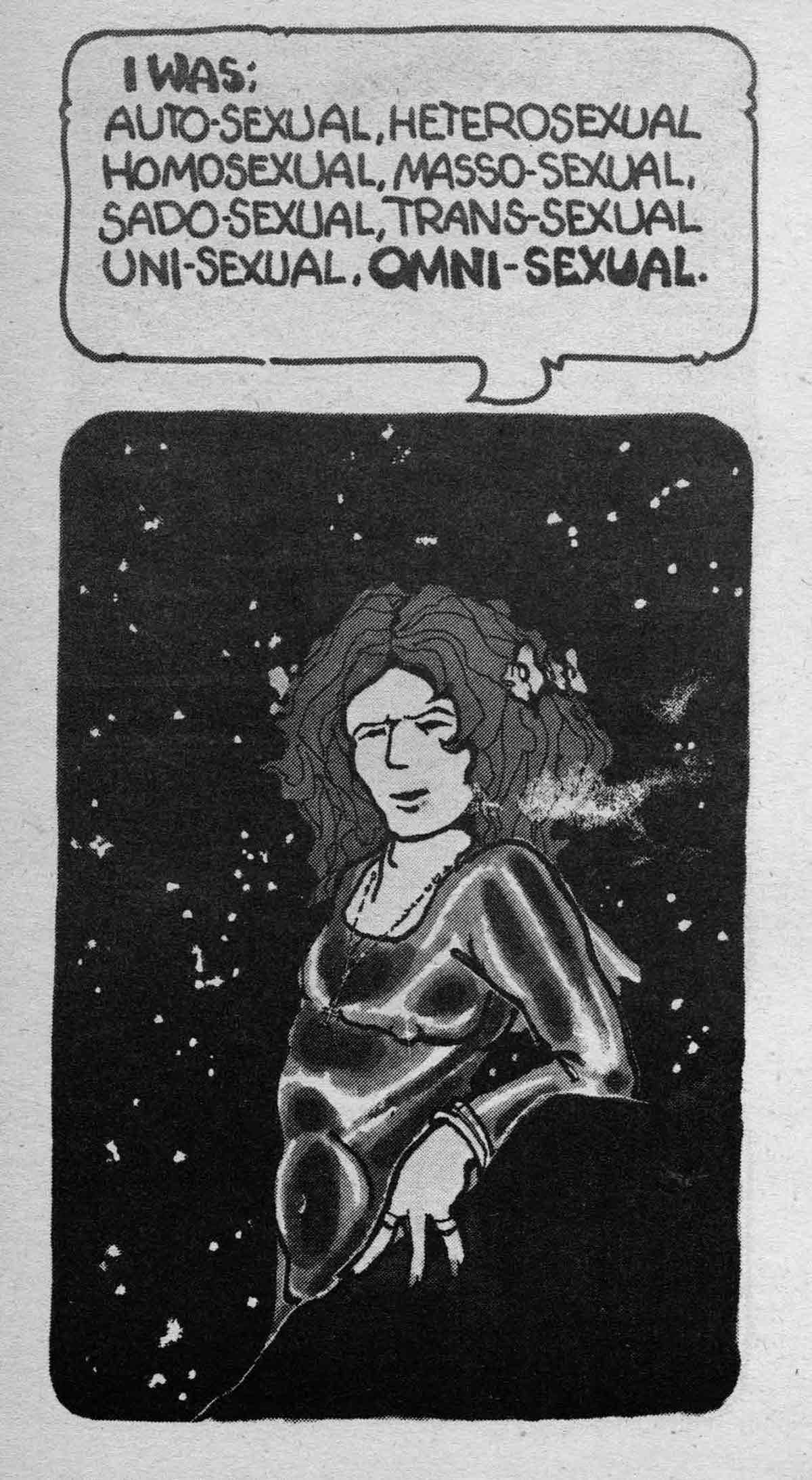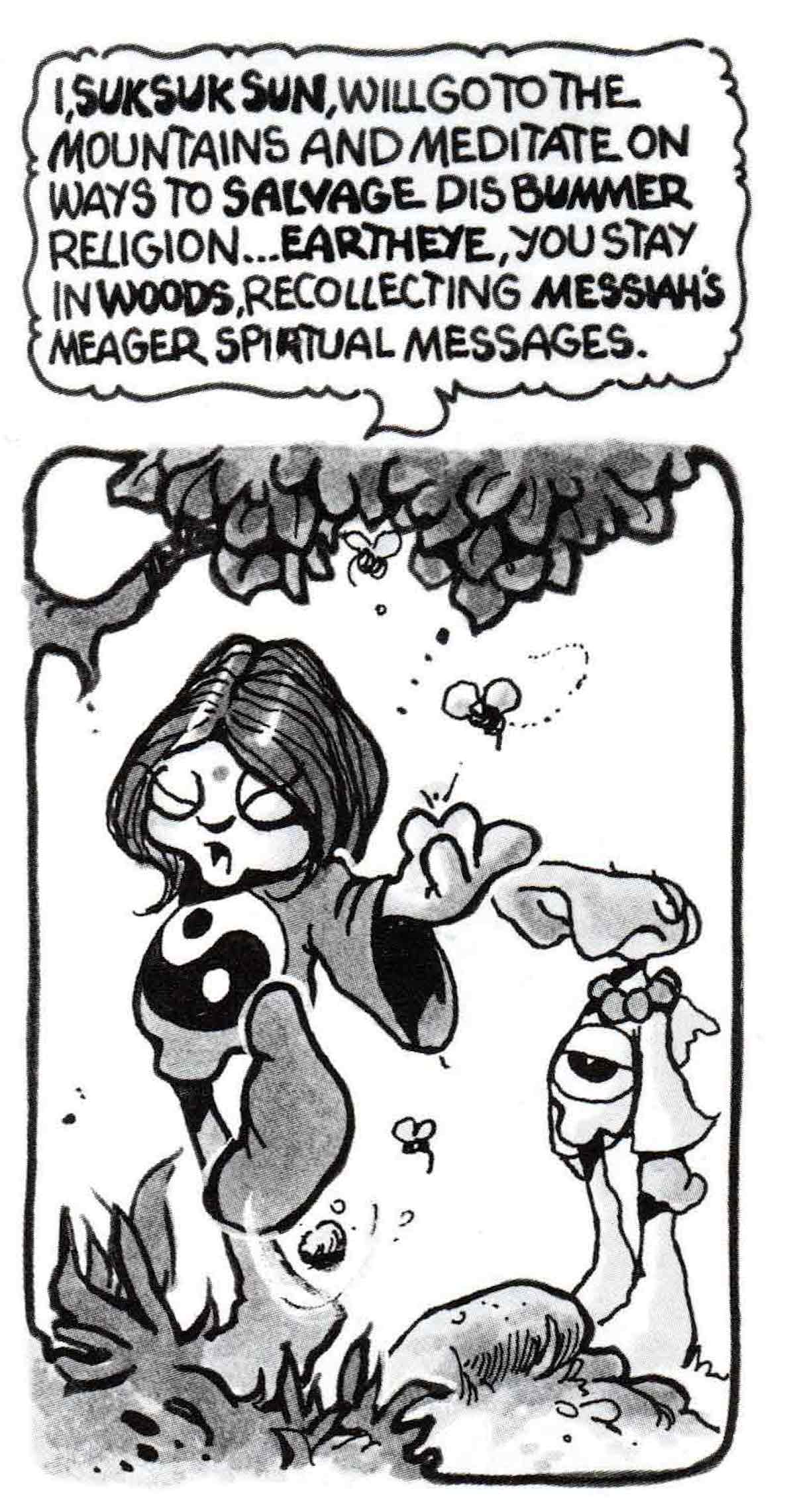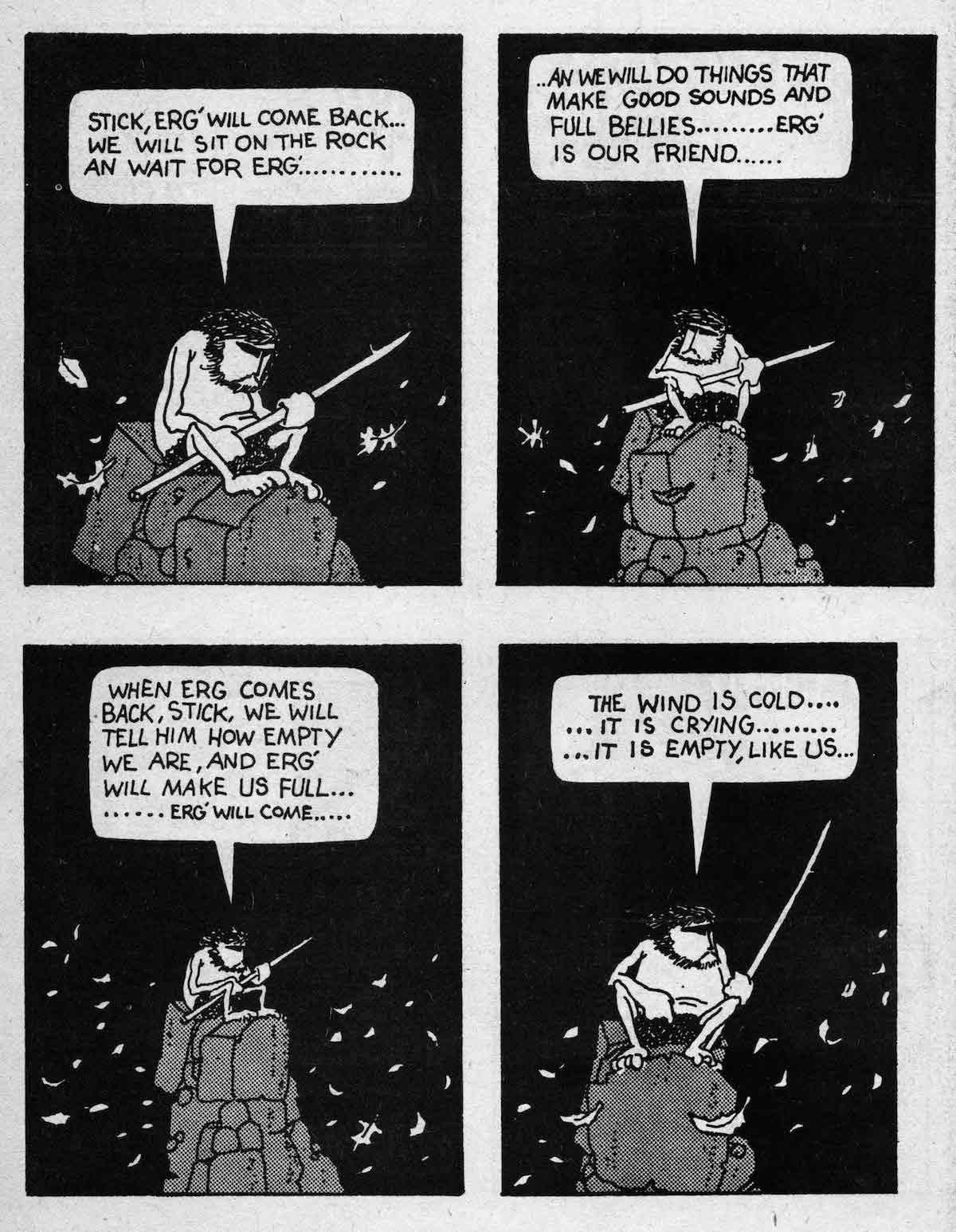Bodē reached his creative stride around 1966 with the publication of Cheech Wizard through Syracuse University Press. If there is a shared comic strip topography, the marshes and meadows of Cheech Wizard’s home planet of Summermouse are located down a dark and twisted path adjacent to Walt Kelly’s Okefenokee Swamp. Here Bodē’s bodacious nymphs and witless lizards lounge on leafy hillocks and knotted trunks while speaking a familiar Pogo patois. Bodē saw Cheech Wizard as his alter ego — a rancorous, hedonistic conman presiding over Underground Comix’ answer to Disneyland. The reach of Cheech Wizard would eventually stretch beyond Bodē’s hometown of Syracuse, with the strip seeing print in skin mags like Cavalier and Swank, not to mention that milestone of American humor, National Lampoon.
By the early 1970s Bodēs imagery had taken root in the hearts and minds of an entire confluence of contemporaries like Ralph Bakshi, Michael Ploog, Berni Wrightson and Jeffrey Catherine Jones. Some happily recognized, even celebrated his influence, others denied his inspiration to the detriment of their integrity.
“I have a lot of people who copy my ideas, but there are more people who copy the style and the approach of other people,” said Bodē in a videotaped interview from 1974’s Toronto Comic Con. “If you want to work for Marvel or DC, that’s alright…but the only way is to do it yourself and do it your way. I was told that I would never have a market. I was told that I’d never be able to make a living doing the kind of art my way. The market is there, and the living is there, but I also wasn’t just satisfied enough to be a cartoonist who would just work in publishing. [I]wanted to develop other forms of art, other platforms for expression.”
Bodē believed an artist’s means of self-expression existed beyond mere craft and style. He saw creativity as a resource generated by a personal dimension or creative continuum. “[N]ot only do you have styles, but you also have levels of reality inside yourself,” he said. “I have sort of a reality level – a little cartoon dream world – and once I get my particular drawings up to a particular level, all of a sudden, I just know it’s done because it’s just clicked inside me. It’s like a light has gone on and this is an acceptable view [into] the little, tiny schizophrenic world inside my head. Other artists do it in their own way and it’s sort of like a process of creating a real place or real thing or real image.”
Bodē not only drew readers, but fellow creators into his cartoon dream world. Using basic pencils and felt markers, Bodē crafted a clean and deceptively complex approach to visual storytelling that was something short of seductive. Air Pirates veteran and National Lampoon compatriot Shary Flenniken says early underground artists were all about the indulgent use of ink, but not Bodē. Time is money in commercial cartooning and a successful artist had to be a high-yield machine. Therefore, to crowd one’s page with detailed imagery was in and of itself an act of rebellion. “And here comes Vaughn,” Flenniken recalls, “with this incredible, loose, non-detailed style that didn’t involve a tedious, crude look. ‘Crude’ was a big thing then. A lot of people were putting a lot of effort into their work, but they couldn’t necessarily draw.” In short, Bodē taught the rebels new battlefield tactics.
Perhaps one of Bodē’s most pervading inspirations was the one most bitterly contested by fans and colleagues: Ralph Bakshi’s 1977 film, Wizards. Even with a passing knowledge of Bodē’s work, it’s hard not to miss the similarities between Avatar the Great and Cheech Wizard, Princess Elinore and any given “Bodē Broad” and, perhaps most significant of all, Cobalt 60’s obvious doppelganger, Necron 99.
“Bakshi, hungry to imitate his success with Fritz the Cat, actually started production on his animated adaptation Bodē’s work before actually seeking permission from the artist,” notes Paco Taylor. “Ultimately, Bodē would forbid Bakshi from using his creations. The animator, having already borrowed heavily from at least two of his best-known works, Cobalt 60 and Cheech Wizard, reworked the production — however slightly — to mask its resemblance to its obvious source material.”
Reportedly, Bodē was interested in an animated collaboration with Bakshi until he saw the latter’s adaptation of Robert Crumb’s Fritz the Cat – a film that ultimately branded Bakshi a sell-out in the Underground community fueled in no small part by Crumb’s own dissatisfaction with the film. It turns out the harsh light cast upon Bakshi may not have entirely warranted. “After Vaughn’s death, Bakshi released Wizards, which Vaughn’s admirers have branded a rip-off ever since,” says Bodē’s friend and collaborator Larry Todd.
“Pushy, little, Napoleon Complex enfant terrible that Bakshi was, there wasn’t anything wrong with him that wasn’t wrong with the rest of us. Crumb thought he was some guy behind a desk using the intercom to tell others what to do. He didn’t realize he had the tender soul of a sensitive artist. It gave Bakshi a bad attitude about us; it gave us a bad attitude about him. We should have taken this man to our hearts and said, ‘Yes, you are a true underground artist. Yes, you are the only one of us who is an animator. Yes, we are alike. Welcome to our parties. Drink our beer. Rip us off. But give us a share.’ “Sure, he ripped Wizards off from Vaughn. But he ripped Wally Wood off just as much.”
Wizards was released in the summer of 1977, two years after Bodē’s death. Bakshi claimed his film might have dominated the box office were it not George Lucas’ little brainchild called Star Wars.
For decades Bakshi was reticent about discussing Bodē’s influence on Wizards until murmurings of a sequel began in 2012, leading Bodē’s son Mark to post to social media, “The day I never thought I would live to see — Ralph Bakshi called and apologized for being so heavily influenced by my father on Wizards!!! And he is sending some stuff of my dad’s he has back to me after 40 years! I told him to throw some signed Wizards cells in with the package and he said, ‘No problem Mark, I’ll get right on it. Well, there ya go, the man has come clean!!”
Today, Bodē’s work pervades like light from a distant galaxy thanks in no small part to his son Mark’s uncanny gift for reflecting the elder’s talents. Only 12-years old when Bodē died, one might argue Mark’s abilities simply a mimetic gift come from a lifetime immersion in his father’s cartoon dream world. Indeed, Mark often recounts how his father kept him preoccupied as a child by paying him a quarter commission for each strip he drew. It goes without saying Mark chose to draw his dad’s stuff, but today when the work of one man is placed beside the other, it’s almost easier to believe the son came to channel the spirit of father.
As a young person Mark was a constant witness to his father’s impact upon West Coast counterculture, but it was not until attending art school in New York that he became aware of far his father’s work had pervaded throughout the world. Street artists had embraced Bodē’s imagery and the celebration was witnessed in alleyways and on subway trains. “The first exposure I had to the graffiti was when I went to the School of Visual Arts in ’81,” Mark recalls. “One day I was just waiting on the platform and a non-stop went by me. As the wind hit me also the imagery on the train hit me and it was like seeing my life flash before my eyes. What is up with my dad? What is going on? That blew my mind. How the fuck did my father touch somebody so much that they’d actually risk their freedom?” From that moment forward, Mark could not help but see his father’s work everywhere.
In time, Mark came to immaculately grok his father’s style making him the consummate student and custodian of his father’s work. “I think it’s the line, the big, bold Bodē line – the holding line that goes around the outside of the character and then there’s thin lines on the inside,” Mark says. “You might do the whole thing in that thin line and then put that big, bold line around the outside. That’s Bodē. And it translates well to the spray can and so some of the earliest graffiti artists that did the trains in New York picked up on that and ran with it. Then people started imitating without even knowing where the characters came from that they were imitating each other. It just kept going and its rippled across the planet. It’s amazing.”
Bodē spent his entire life wrestling with the ebb and flow of his mental health. Diagnosed as a paranoid schizophrenic in the mid-1960s, he embraced the opportunity to eschew a mundane and colorless reality by adopting a fluid sexual identity and voracious carnal appetite. “I was: auto-sexual, heterosexual, homosexual, trans-sexual, uni-sexual, omni-sexual,” he declared in his comic Cheech Wizard/Schizophrenia (1973). “Problem with me was, I didn’t just want to be any one thing anymore. I wanted to be a whole spectrum of human things: man, woman, child, artist, student, lover, warrior…the price to be me is high, and not done even now but I found my plumbline to soul. We are aligned and flowing smooth wherever our course is to go.”
According to Mark Levin, in embracing a saturnalian identity Bodē found his beginning and his end. “Vaughn’s solution to [our] casual, inevitable destruction was absolute sexual indulgence. His cartoons rippled with celebratory references to cunnilingus and fellatio, masturbation and S&M. His call had a philosophical/theological basis. ‘We don’t just ball each other,’ he wrote. ‘We ball life.’ Repressing sex causes us to obsess about it. These obsessions block our minds so that we cannot receive God. Vaughn wanted to open everyone to this reception. Something must fill us besides what he knew otherwise to be there.”
In refining a persona that defied societal norms and a voice that called out for compassion and empathy, Bodē seemed confounded when confronted over the misogyny found in his work.
In addition to his visionary talents as an illustrator, Bodē was also a consummate performer. When not at his drawing board, he toured a live, solo Cartoon Concert series where he utilized a slide projector and his gift for cartoon voices to bring his comics to life. The show was wildly successful with Bodē booking numerous college tours. He eventually discovered not everyone in his audience liked the show.
“Some people find it difficult to digest,” Bodē said. “I try to do a disclaimer before I start and excuse the people out there who don’t have a free humor — a free scope of humor. I get a lot of people who are uptight like someone from women’s liberation will sometimes approach me in a threatening manner after my show. I was here in Toronto when I did the World Science Fiction Convention last year and they had representatives from Ms. Magazine who left shortly after my show began, but they came back afterwards so they could rag on me. Nobody can censor me, otherwise I wouldn’t work, I wouldn’t care, I would give up all my artwork, I’d give up all my paying jobs if I were censored, because that’s the one thing that stopped me.”
Bodē’s strips were also peppered with a considerable amount of bigotry and racism, particularly in the latter installments of Cheech Wizard and the arrival of a character called SukSukSun, also referred to as the Gook. Bodē drew SukSukSun with slanted eyes and a yin and yang symbol upon his chest and positioned him as a foil to Cheech’s role as chief hedonist and would-be messiah within the Summermouse woodland community. SukSukSun doles out as much ball-kicking and disdain for humanity as Cheech, but there is no getting past the fact SukSukSun’s presence in the strip, his stereotypical image and stilted use of English were a comment on the conflict in Vietnam and the aggression directed at Asian people. An aggression we have yet to overcome. One wonders if Bodē had lingered longer on this plain of existence would he have left his less empathetic qualities behind?
Bodē’s desire to shuck the casings of repression and transcend the slings and arrows of this reality led him to experiment with drugs, sex, and auto-erotic asphyxiation – an experiment that ultimately led to his tragic and untimely end. He unabashedly stated he was looking for God. Only he can confirm his success.
Bodē often touted Cheech Wizard as his alter ego, but his strip The Man (Print Mint, 1972) is arguably his most personal. The Man ran in the Syracuse Daily Orange from 1965 to 1966. It tells the story of a lonely caveman wandering a barren landscape with his only companion, a stick called Stick. The Man finds a friend in a giant lizard he dubs Erg. After Erg inadvertently teaches the Man to laugh, the lizard becomes a meal for another caveman. The Man quickly dispatches the intruder with no remorse and ultimately demonstrates more emotional connection to Stick and his deceased lizard pal than a fellow human being. The comic closes with The Man sitting alone atop a rocky tower, crying out his loneliness to the wind. The Man is a perfect sampling of Bodēs crisp, illustrative style as well as his gift for gritty, existential humor; it was also one of the most self-reflective pieces Bodē had ever committed to paper.
In his brief life Vaughn Bodē received a Hugo Award, the Yellow Kid Award, an Inkpot Award and was posthumously inducted into the Eisner Hall of Fame in 2006. He left behind volumes of journals, sketchbooks, paintings and strips all testifying to the complexity of his personality and the simple brilliance of his gift for illustration. “The thing that makes a character an icon is usually one line – one line can express a character,” says Mark. “[L]ike Mickey Mouse’s ears and nose. Characters like these are icons, but they are also designed so you can draw them easily.” Perhaps that is Bodē’s true legacy — the tragic elegance of a simple, expressive line we can follow beyond the page.
